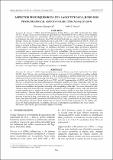Por favor, use este identificador para citar o enlazar este ítem:
https://hdl.handle.net/20.500.12958/5882| Título : | Aspectos físicoquímicos del lago Titicaca, julio 2019 |
| Otros títulos : | Physicochemical aspects of Lake Titicaca (July 2019) |
| Autor : | Siguayro M., Humberto Franco, Yerko B. |
| Palabras clave : | Lago Titicaca;Aspectos fisicoquímicos,;Variabilidad |
| Fecha de publicación : | dic-2022 |
| Editorial : | Instituto del Mar del Perú |
| Citación : | Siguayro, H., Franco, Y. (2022). Aspectos físicoquímicos del lago Titicaca, julio 2019. Inf Inst Mar Perú. 49(4): 538-551. |
| Citación : | Informe IMARPE 49(4), 2022; |
| Resumen : | El lago Titicaca es el ecosistema de agua dulce más importante de Perú y Bolivia, provee múltiples beneficios socioeconómicos y ambientales, además constituye una reserva de agua dulce primordial para los habitantes del anillo circunlacustre. En el 2019, del 10 al 24 de julio, se realizó la evaluación limnológica del lago Titicaca por el equipo conformado por Imarpe, PELT y ALT (representante de MAYA y PACU de Bolivia), con el objetivo de caracterizar las variables físicas, químicas, biológicas y su relación con la biomasa íctica en la bahía de Puno, Lago Mayor y Lago Menor. Se establecieron 71 estaciones de muestreo en 8 perfiles según la morfología del lago. Los resultados obtenidos en el Lago Mayor presentaron gradiente de temperatura con mezcla incompleta, con altos contenidos de oxígeno disuelto por encima de 50 m de profundidad que no mostró anoxia a más de 250 m de profundidad, pH con tendencia básica; así mismo, se encontraron concentraciones elevadas de fosfatos y nitratos en el hipolimnion, sin embargo, para el silicato y nitritos fue fluctuante. La máxima de clorofila-a se presentó entre 10 y 50 m de profundidad. En la bahía de Puno, Lago Menor y zonas someras, estos parámetros fisicoquímicos presentaron fluctuaciones, concentraciones elevadas de fosfatos, nitratos y clorofila-a frente a la desembocadura del río Coata y Suches y frente a Desaguadero en el Lago Menor. Se apreciaron niveles altos de variabilidad principalmente los fosfatos y nitratos en columna de agua. ABSTRACT: Lake Titicaca is the most important freshwater ecosystem in Peru and Bolivia, providing multiple socioeconomic and environmental benefits, as well as constituting an essential freshwater reserve for the inhabitants of the circumlacustrine ring. From July 10 to 24, 2019, the limnological assessment of Lake Titicaca was carried out by the team formed by Imarpe, PELT, and ALT (representative of MAYA and PACU from Bolivia), to characterize the physicochemical and biological variables and their relationship with the fish biomass in the Puno Bay and Lake Titicaca’s deep main basin and shallow sub-basin. A total of 71 sampling stations were established in 8 profiles according to the morphology of the lake. The results obtained in Lake Titicaca’s deep main basin showed a temperature gradient with incomplete mixing, with high dissolved oxygen contents above a depth of 50 m that did not show anoxia at depths of more than 250 m, pH with a basic tendency. Likewise, high concentrations of phosphates and nitrates were found in the hypolimnion; nevertheless, for silicate and nitrites, the concentration was fluctuating. The maximum chlorophyll-a occurred between 10 and 50 m deep. In the Puno Bay, Lago Titicaca’s shallow sub-basin, as well as in other shallow areas, these physicochemical parameters showed fluctuations, high concentrations of phosphates, nitrates, and chlorophyll-a off of the mouth of the Coata and Suches rivers and off Desaguadero in the shallow subbasin. We observed high levels of variability, especially for phosphates and nitrates in the water column. |
| URI : | https://hdl.handle.net/20.500.12958/5882 |
| ISSN : | 0378-7702 |
| Aparece en las colecciones: | Informe vol. 49(4) 2022 |
Ficheros en este ítem:
| Fichero | Descripción | Tamaño | Formato | |
|---|---|---|---|---|
| Informe 49-4 artículo 5.pdf | 1,5 MB | Adobe PDF |  Visualizar/Abrir |
Este ítem está sujeto a una licencia Creative Commons Licencia Creative Commons

